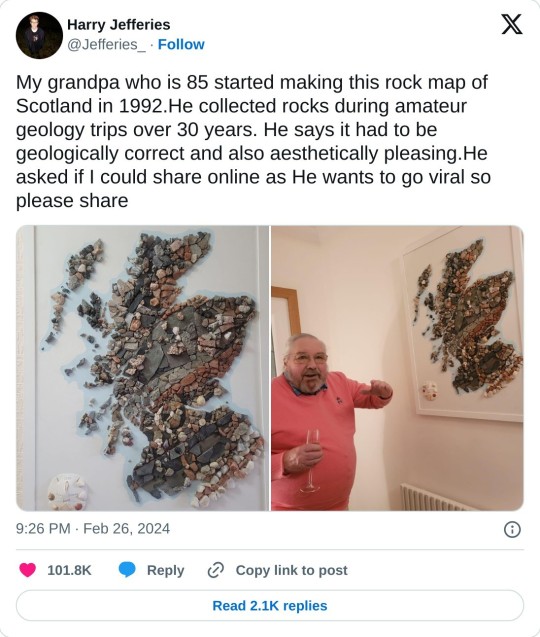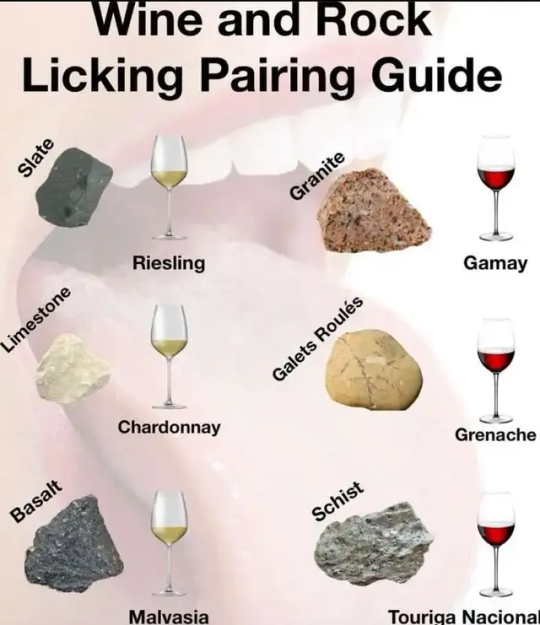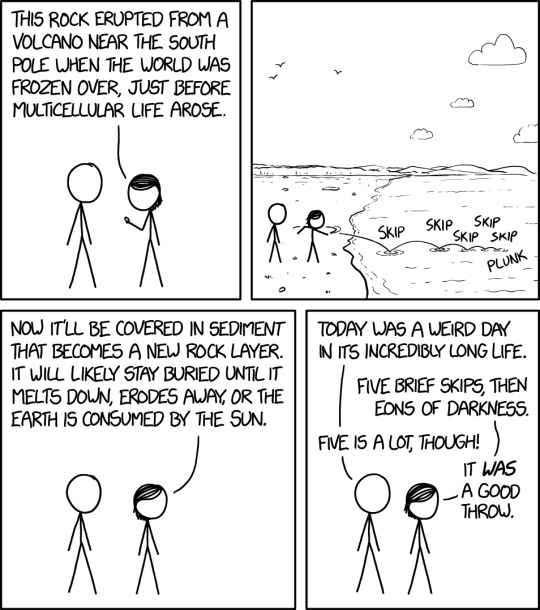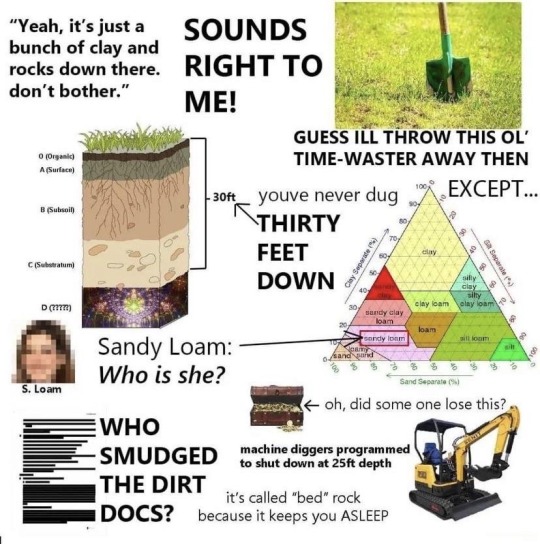#@geology
Text

#geology#scotland#i haven't worked in geology in 30 years#but it's still dangerous to let me drive when the geology is interesting#@ayeforscotland#but i am still a cartographer#and this is a way cool map
119K notes
·
View notes
Text
my friend told me that her boyfriend got her a super cool rock while they were on vacation together and you would not BELIEVE my disappointment when i realized she was talking about her engagement ring
#this is a silly goofy mood post pls no being weird or taking it too seriously ok? ok :)#yes yes ur engaged congrats but also why would u get me excited about a rock#when no rock#eslyea#geology#rocks
222K notes
·
View notes
Text

A stunning iridescent ammonite fossil. [source]
#iridescent#angelcore#ammonite#fossil#ammonite fossil#geology#aesthetic#beach#ocean aesthetic#oceanic#nature#naturecore#earth#earthy#earthcore#nature aesthetic#earthy aesthetic#science
15K notes
·
View notes
Text
We ask your questions so you don’t have to! Submit your questions to have them posted anonymously as polls.
#polls#incognito polls#anonymous#tumblr polls#tumblr users#questions#polls about the world#submitted may 28#geology#mountains
8K notes
·
View notes
Text
A juvenile bug isn't called a larva until it reaches the surface. While it's still underground it's called a margma
19K notes
·
View notes
Text

It me
55K notes
·
View notes
Text



Random Assets from a Junior Ranger book I helped out with
7K notes
·
View notes
Text

9K notes
·
View notes
Text

Aquamarine with Morganite from Minas Gerais, Brazil. By dusted77 on Instagram.
#aquamarine#morganite#mineral#minerals#exhibit#exhibits#minas gerais#brazil#munich#germany#geology#nature
10K notes
·
View notes
Text
I’ve been doing some field work with geologists this winter and I’m kind of amazed by how these dudes can pick up a handful of dirt and talk about it for an hour using terms I’ve never heard of. Like wow you see a whole universe in there that I don’t. The world is truly full of beauty and we only comprehend a fraction of it.
10K notes
·
View notes
Text

i think we should all consider getting emotional over this xkcd. as a group. let's get emotional about it
31K notes
·
View notes
Text
Holy shit holy shit holy Schist!!!!!
A hydrothermal explosion happened Yellowstone!! And I’m alive to see it! I wish I was there.
From USGS Facebook:
A small hydrothermal explosion occurred in Yellowstone National Park today (July 23, 2024) around 10:00 AM MST in the Biscuit Basin thermal area, about 2.1 miles (3.5 km) northwest of Old Faithful. Numerous videos of the event were recorded by visitors. The boardwalk was damaged, but there were no reports of injury. The explosion appears to have originated near Black Diamond Pool.
Biscuit Basin, including the parking lot and boardwalks, are temporary closed for visitor safety. The Grand Loop road remains open. Yellowstone National Park geologists are investigating the event.
Hydrothermal explosions occur when water suddenly flashes to steam underground, and they are relatively common in Yellowstone. For example, Porkchop Geyser, in Norris Geyser Basin, experienced an explosion in 1989, and a small event in Norris Geyser Basin was recorded by monitoring equipment on April 15, 2024. An explosion similar to that of today also occurred in Biscuit Basin on May 17, 2009.
More information about hydrothermal explosions is available at https://www.usgs.gov/observatories/yvo/news/hydrothermal-explosions-yellowstone-national-park.
Monitoring data show no changes in the Yellowstone region. Today’s explosion does not reflect activity within volcanic system, which remains at normal background levels of activity. Hydrothermal explosions like that of today are not a sign of impending volcanic eruptions, and they are not caused by magma rising towards the surface.
Additional information will be provided as it becomes available.
The Yellowstone Volcano Observatory (YVO) provides long-term monitoring of volcanic and earthquake activity in the Yellowstone National Park region. Yellowstone is the site of the largest and most diverse collection of natural thermal features in the world and the first National Park. YVO is one of the five USGS Volcano Observatories that monitor volcanoes within the United States for science and public safety.
YVO Member agencies: USGS, Yellowstone National Park, University of Utah, University of Wyoming, Montana State University, UNAVCO, Inc., Wyoming State Geological Survey, Montana Bureau of Mines and Geology, Idaho Geological Survey
Image courtesy of Vlada March.
3K notes
·
View notes
Text
geology students will literally say shit like “my dirt class was cancelled today” or “the professor for my class on sand gave us homework about worms” like we’re 8 year olds on the playground inventing new terms for playing in the grass during recess
6K notes
·
View notes
Text
A lot of times, when people talk about mad scientists, they mean medical or biology or chemistry, sometimes you'll have a physicist or mathematician or even an engineer... But let's not forget about the hard working mad science geologists who help people scout out and build their "evil lair in a volcano" while furthering their own plot to rid the world of their competition by using their own egos against them. Meanwhile they're bending the secrets of the earth to their will, making new and strange crystalline mineral structures, and dialing in the frequency of their earthquake generators to only destroy what they're aiming at. They deserve attention too!
6K notes
·
View notes
Text
Scientists proposed a novel idea on Wednesday that could solve two of the world's mysteries at once—one that passes over our heads every night, and one that sits far below our feet.
The first mystery has puzzled everyone from scientists to inquisitive children for millennia: where did the moon come from?
The leading theory is that the moon was created 4.5 billion years ago when a would-be planet the size of Mars smashed into the still-forming Earth.
This epic collision between early Earth and the proto-planet called Theia shot an enormous amount of debris into orbit, which formed what would become the moon.
Or so the theory goes. Despite decades of effort, scientists have not been able to find any evidence of Theia's existence.
New US-led research, published in the journal Nature, suggests they might have been looking in the wrong direction.
Around 2,900 kilometers (1,800 miles) below Earth's surface, two massive "blobs" have baffled geologists since seismic waves revealed their existence in the 1980s.
Continue Reading.
12K notes
·
View notes
